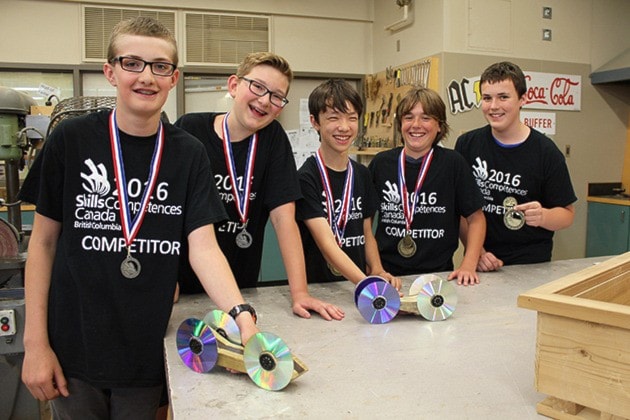Chilliwack Middle School students might not be old enough to drive yet, but they have fast cars. Really fast cars.
They built them in their shop class, taught by Gerald Buchwitz and Dan Causton, preparing for the regional Skills Canada gravity car competition.
The cars are judged by how fast they travel down a track, and the only source of energy is the potential energy generated from gravity.
Using common shop materials like wood, metal, plastic and recycled electronic pieces, students must make the vehicles from scratch. The maximum size of the car is 4" wide, 6" tall, and 12" in length, and it is weight restricted to 600 grams.
Two Grade 8 teams from CMS raced their handmade cars at the regional competition on March 3 at the UFV Trades and Technology Centre. Junior students were also participating in the spaghetti bridge and robotics competitions, while high school students competed in skilled trades including automotive, carpentry, culinary and more.
Nathan Woodrow and Dylan Putz won silver that day, while Keith Stoner, Josh Guretzki and Martin Kannegieter took the top spot, allowing them to advance to provincials.
After competing against a dozen other teams at the provincial competition in Abbotsford on April 13, CMS took home the B.C. gold.
From a dead stop, their car raced down the 32 foot track in just 2.9~ seconds. All other teams were 3.0s or over.
"We've been going to the competition for years," Buchwitz said. "This is the first time we've won anything there."
It took a lot of trial an error to get them there. With each design and test, they would brainstorm, redesign and rebuild to try and make a faster time.
"They had the perseverance to go through all those mundane steps again and again," Buchwitz explained. "They figured out how to make it the fastest car possible."
 They cut and sanded wooden blocks into aerodynamically efficient bodies, used CDs as wheels for a better rolling mass, added metal slugs for weight, they drilled one hole after the next to ensure the axle was perfectly straight.
They cut and sanded wooden blocks into aerodynamically efficient bodies, used CDs as wheels for a better rolling mass, added metal slugs for weight, they drilled one hole after the next to ensure the axle was perfectly straight.
Showing great ingenuity, they shredded and applied graphite from pencils to decrease friction between the metal and the wood.
After they celebrated their win, these racers stuck around to watch the higher-level competitions unfold.
"It was awesome," Putz said.
"They were all super focused," Kannegieter said of the high school competitors. "We were all cheering for each other [in our competition], but they were so quiet."
One of the greatest benefits of the junior competitions, and the purpose of the challenge, is to expose the middle school students to the various trades and technology careers through a hands-on experience.
"Just to get them into that scene, I think it's really inspiring to give them that exposure," Buchwitz said.
While they still have plenty of time to explore their various career paths, these grade 8 students mentioned that they are already thinking about pursuing trades in automotive, welding and electrical fields.
